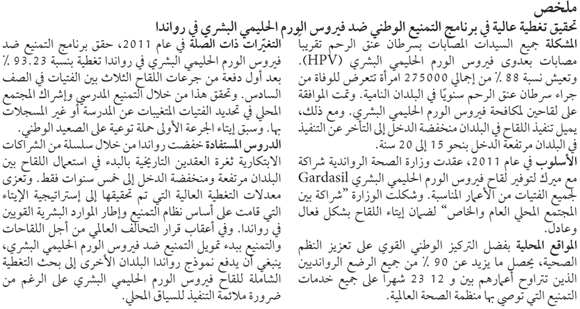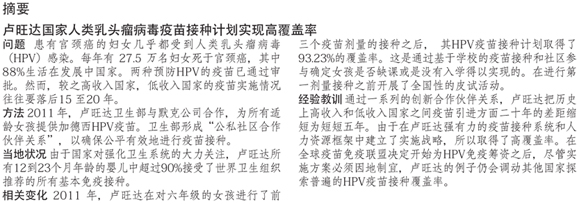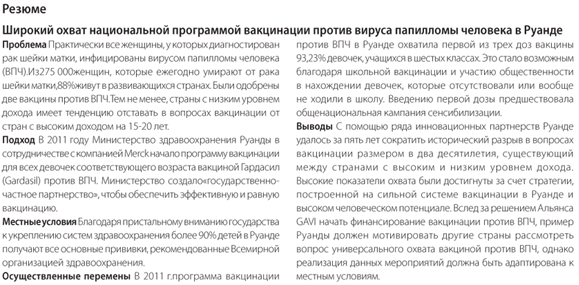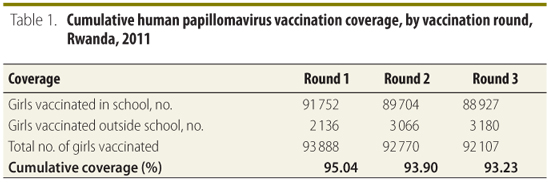LESSONS FROM THE FIELD
Achieving high coverage in Rwanda's national human papillomavirus vaccination programme
Atteinte d'un niveau de couverture élevé pour le programme national rwandais de vaccination contre le papillomavirus humain
Cómo alcanzar una cobertura elevada en el programa nacional de vacunación contra el virus del papiloma humano en Rwanda
Agnes BinagwahoI; Claire M WagnerII,*; Maurice GateraIII; Corine KaremaIII; Cameron T NuttIV; Fidele NgaboI
IMinistry of Health, Kigali, Rwanda
IIDepartment of Global Health and Social Medicine, Harvard Medical School, 641 Huntington Avenue, Boston, MA 02115, United States of America (USA)
IIIRwanda Biomedical Center, Kigali, Rwanda
IVDartmouth Center for Health Care Delivery Science, Hanover, USA
ABSTRACT
PROBLEM: Virtually all women who have cervical cancer are infected with the human papillomavirus (HPV). Of the 275 000 women who die from cervical cancer every year, 88% live in developing countries. Two vaccines against the HPV have been approved. However, vaccine implementation in low-income countries tends to lag behind implementation in high-income countries by 15 to 20 years.
APPROACH: In 2011, Rwanda's Ministry of Health partnered with Merck to offer the Gardasil HPV vaccine to all girls of appropriate age. The Ministry formed a "publicprivate community partnership" to ensure effective and equitable delivery.
LOCAL SETTING: Thanks to a strong national focus on health systems strengthening, more than 90% of all Rwandan infants aged 1223 months receive all basic immunizations recommended by the World Health Organization.
RELEVANT CHANGES: In 2011, Rwanda's HPV vaccination programme achieved 93.23% coverage after the first three-dose course of vaccination among girls in grade six. This was made possible through school-based vaccination and community involvement in identifying girls absent from or not enrolled in school. A nationwide sensitization campaign preceded delivery of the first dose.
LESSONS LEARNT: Through a series of innovative partnerships, Rwanda reduced the historical two-decade gap in vaccine introduction between high- and low-income countries to just five years. High coverage rates were achieved due to a delivery strategy that built on Rwanda's strong vaccination system and human resources framework. Following the GAVI Alliance's decision to begin financing HPV vaccination, Rwanda's example should motivate other countries to explore universal HPV vaccine coverage, although implementation must be tailored to the local context.


RÉSUMÉ
PROBLÈME: Pratiquement toutes les femmes touchées par le cancer du col de l'utérus sont infectées par le virus du papillome humain (VPH). Parmi les 275 000 femmes qui meurent chaque année d'un cancer du col utérin, 88% d'entre elles vivent dans des pays en voie de développement. Deux vaccins contre le VPH ont été approuvés. Toutefois, l'instauration du vaccin dans les pays à revenu faible reste à la traîne depuis 15 à 20 ans par rapport à sa mise en ceuvre dans les pays à revenu élevé.
APPROCHE: En 2011, le ministère de la Santé du Rwanda a créé un partenariat avec Merck pour offrir le vaccin Gardasil contre le VPH à toutes les filles d'âge approprié. Le ministère a établi un «partenariat communautaire public-privé» pour en assurer une délivrance efficace et équitable.
ENVIRONNEMENT LOCAL: Grâce à un effort national majeur en matière de renforcement des systèmes de santé, plus de 90% de tous les nourrissons rwandais âgé de 12 à 23 mois reçoivent l'ensemble des vaccins de base recommandés par l'Organisation mondiale de la Santé.
CHANGEMENTS SIGNIFICATIFS: En 2011, le programme rwandais de vaccination contre le VPH a atteint une couverture de 93,23% après la première cycle de trois doses de vaccin parmi les filles de niveau CM2. Cela a été rendu possible grâce à une vaccination en milieu scolaire et à l'implication communautaire dans l'identification des filles absentes ou non inscrites à l'école. Une campagne nationale de sensibilisation a précédé l'administration de la première dose.
LEÇONS TIRÉES: Grâce à une série de partenariats novateurs, le Rwanda a réduit l'écart historique de deux décennies à seulement cinq ans quant à l'introduction d'un vaccin dans les pays à revenu élevé et faible. Des taux de couverture élevés ont été atteints grâce à une stratégie de délivrance basée sur un système de vaccination solide au Rwanda et à une organisation efficace des ressources humaines. Suite à la décision de l'Alliance GAVI d'initier le financement de la vaccination contre le VPH, l'exemple du Rwanda devrait inciter d'autres pays à envisager une couverture totale du vaccin contre le VPH, bien que la mise en ceuvre doive être adaptée au contexte local.

RESUMEN
SITUACIÓN: Casi todas las mujeres que tienen cáncer cervicouterino están infectadas con el virus del papiloma humano (VPH). De las 275 000 mujeres que fallecen anualmente debido al cáncer cervicouterino, el 88% vive en países en desarrollo. Se han aprobado dos vacunas contra el VPH, no obstante, la implantación de la vacuna en países de ingresos bajos tiende a quedar entre 15 y 20 años por detrás de su aplicación en países de ingresos altos.
ENFOQUE: En 2011, el Ministerio de Sanidad de Rwanda se asoció con Merck para ofrecer la vacuna Gardasil contra el VPH a todas las niñas en la edad adecuada. El Ministerio formó una «asociación comunitaria público-privada» para garantizar un reparto eficaz y equitativo de la misma.
MARCO REGIONAL: Más del 90% de los niños de 12 a 23 meses de edad en Rwanda ha recibido todas las vacunas básicas recomendadas por la Organización Mundial de la Salud gracias a los esfuerzos gubernamentales por mejorar los sistemas sanitarios.
CAMBIOS IMPORTANTES: El programa de vacunación contra el VPH en Rwanda alcanzó una cobertura del 93,23% entre las niñas de sexto curso en el año 2011 al cabo de la primera ronda de vacunación con las tres dosis. Esto fue posible a través de la vacunación escolar y gracias a la participación de la comunidad para identificar a las niñas que faltaban o no estaban matriculadas en el colegio. Una campaña de sensibilización a escala nacional precedió la entrega de la primera dosis.
LECCIONES APRENDIDAS: A través de una serie de asociaciones innovadoras, Rwanda redujo a tan solo cinco años la brecha histórica de dos décadas en cuanto a la introducción de la vacuna entre países de ingresos altos y bajos. Una estrategia de reparto construida sobre el sólido sistema de vacunación y el marco de recursos humanos de Rwanda permitió alcanzar una cobertura elevada. Siguiendo la decisión de la GAVI Alliance de comenzar a financiar la vacuna contra el VPH, el ejemplo de Rwanda debería animar a otros países a investigar la cobertura de la vacuna universal contra el VPH, aunque su aplicación deberá adaptarse al contexto local.
Background
Human papillomavirus (HPV) is a sexually transmitted virus found in virtually all cases of cervical cancer,1 which kills 275 000 women every year2 and is the biggest contributor to years of life lost from cancer among women in the developing world.3 Two HPV vaccines developed in recent years Merck's quadrivalent Gardasil and GlaxoSmithKline's bivalent Cervarix have been prequalified by the World Health Organization (WHO) and approved by national governments in many countries, including Rwanda. These vaccines represent a milestone in biomedical progress towards mitigating the burden of cervical cancer.4 Vaccination programmes have changed the landscape of global health drastically by enabling countries to re-evaluate funding priorities and to invest in prevention when cost-effective.5 However, 15 to 20 years usually pass between the introduction of a vaccine in rich and poor countries.6
In recent decades, routine screening programmes have reduced cervical cancer morbidity and mortality in high-income countries, and this trend is expected to accelerate as vaccination coverage is scaled up.7 As a result, 77% of new cases8 and 88% of deaths from the disease now occur in developing countries.2 A five-year delay in introducing the HPV vaccine to these countries would result in 1.5 to 2 million preventable deaths.2
Cervical cancer is the most common cancer among women in Rwanda,9 a country in eastern African with more than 11 million inhabitants. In 2010, 986 cases of cervical cancer were diagnosed in Rwanda and 678 women died from the disease.9 That same year, Rwanda evaluated options for HPV vaccination rollout and decided to pursue a partnership with Merck to offer Rwanda's young girls the opportunity to receive a life-saving vaccine.
A growing body of scientific literature has emerged in recent years concerning the use of the HPV vaccine in the developing world,2,10 but very little evidence on the success and replicability of nationwide delivery programmes, like Rwanda's, has been published. In this article, we describe the process by which Rwanda became the world's first low-income country to provide universal access to the HPV vaccine.
Context
Before 2011, neither cervical cancer screening nor HPV vaccination was available in public health facilities in Rwanda; only a few private clinics and nongovernmental organizations offered screening services. Aware that cervical cancer is highly prevalent in Rwanda, the Ministry of Health considered the overwhelmingly positive evidence of the effectiveness of the HPV vaccine to be a call to action.
In April 2009, Rwanda's First Lady met with senior Merck officials to initiate advocacy for the HPV vaccine on behalf of women in Rwanda. An internal technical discussion then occurred between Merck and the Ministry of Health, followed by conversations with development partners in Rwanda's health sector. In April and October 2010, Merck representatives visited Rwanda to work under the leadership of the Ministry of Health in developing a national cervical cancer prevention strategy. Rwanda's National Strategic Plan for the Prevention, Control, and Management of Cervical Lesions and Cancer11 includes screening and vaccination programmes for women between 35 and 45 years of age, the specifics of which will be detailed in future articles. A memorandum of understanding signed in December 2010 guaranteed Rwanda three years of vaccinations at no cost and concessional prices for future doses.
On 26 and 27 April 2011, 93 888 Rwandan girls in primary grade six received their first shot of Gardasil with no out-of-pocket payment. Data collected by the Ministry of Health during the first round of vaccination showed that 94 141 girls were present at school and that 4 651 girls were either absent or not enrolled, resulting in a total of 98 792 eligible girls across Rwanda. The programme's first round achieved 95.04% coverage, the second 93.90% and the third, 93.23% (Table 1).

Rwanda's health sector
Driven by the pursuit of equity, value and quality, the health sector in Rwanda has made immense progress in recent years. Through a decentralization strategy harnessing Rwanda's 45 000 community health workers, the Ministry of Health and its partners have succeeded in decreasing the burden of major infectious diseases and have scaled up disease prevention programmes efficiently and effectively. Between 2005 and 2010, Rwanda reduced malaria incidence by 70% and under-five mortality by 50%. The country increased the proportion of infants aged 1223 months receiving all basic WHO immunizations from 75.2% to 90.1% (with all but oral polio vaccine coverage rates exceeding 95% in 2010) and assured universal access to antiretroviral therapy.12,13 Rwanda has also strategically positioned itself to tackle non-communicable diseases by building on its successful integration of infectious disease interventions and primary health care.14,15
Preparation and implementation
Three early decisions were crucial to the success of Rwanda's HPV vaccine rollout. First, the Ministry of Health decided in September 2010 to widen its technical working group on vaccinations to include the Ministry of Education, the Ministry of Gender and Family Promotion, the Center for Treatment and Research on AIDS, Tuberculosis, Malaria, and other Epidemics, and health workers engaged in cancer care. Multidisciplinary subcommittees were tasked with identifying cold chain requirements; numbers of girls in and out of school; nurse and community health worker training capacity; procurement and distribution logistics; a budget for implementation; education and sensitization requirements; and tools for data collection and social mobilization. Committees met as often as needed often every other day for about four months. After the memorandum of understanding between Merck and the government of Rwanda was signed, the following two months were spent devising a strategic plan for rollout preparation, implementation and evaluation.
Concurrently, a nationwide population sensitization campaign was planned and undertaken months in advance of vaccination. Speeches by health-care professionals, local government officials, clergy and the First Lady were made to inform parents and children of the new vaccine. Announcements via newspapers, magazines, radio and television were included in the communications strategy. Teachers were trained and encouraged to discuss cervical cancer and the HPV vaccine with students.
With technical assistance from the US Centers for Disease Control and Prevention (CDC) and the International Center for AIDS Care and Treatment Programs (ICAP) at Columbia University, Rwanda's Ministry of Health conducted a situational analysis in March 2011 using in-depth interviews and focus group discussions to assess the knowledge, attitudes and beliefs of key stakeholders pertaining to HPV vaccination. The systematic inclusion of local leaders, community health workers and teachers in the vaccine delivery strategy combined with Merck's in-kind support to constitute a "public-private-community partnership" for effective programme implementation specific to the Rwandan context.
The second major decision was to partner with the Ministry of Education to design a school-based strategy to deliver the standard three doses of the HPV vaccine. Because 98% of Rwandan girls attend primary school,16 implementers felt that the highest coverage rates could be attained through schools. Some girls in rural settings are unaware of their exact ages, and a demonstration project in Uganda described difficulties identifying girls through an age-based programme,10 so Rwanda elected to pursue a grade-based strategy.
Third, the technical working group decided on a multi-phased vaccination strategy spanning three years (Fig. 1). Every year beginning in 2011, girls enrolled in primary grade six will receive the full three-dose course of HPV vaccine. During the programme's second and third years, a "catch-up" phase targeting girls in the third year of secondary school will ensure complete coverage of all pre-adolescent and adolescent girls. In 2014 and beyond, only primary grade six vaccinations will be necessary.

Each course of vaccination takes place over six days: school-based vaccinations across the country during the first two days, out-of-school girls are tracked and vaccinated on the third day, and surveillance of adverse events is conducted over the remaining three days. The vaccination is a voluntary opt-out intervention offered to all girls in the targeted age groups, regardless of their school enrolment status. Parents and guardians had been instructed through the massive communications and media campaigns to accompany their daughters to school on the day when the first dose was going to be administered. If a parent or guardian did not come to the school, the girl did not receive the vaccine. On the days when vaccines are administered, which the schools now designate as educational "health days", local health-care providers and teachers discuss topics pertaining to hygiene, nutrition, infectious diseases and reproductive health.
The vaccination programme technical working group chose to target girls in primary grade six because most of them are not yet sexually active but have reached an appropriate age for initiating sexual education. In Rwanda, the median age of sexual debut is 20.7 years and only 2.7% of girls have had sex by age 15.13
Delivery challenges
During the first phase of the vaccination rollout, one of the greatest challenges faced by implementers was making the population across the country aware of eligibility guidelines for the HPV vaccination. Some parents wanted to have all of their children immunized, and several female teachers in schools where the vaccine was delivered also asked to be vaccinated. Through radio and on-site communication, representatives of the Ministry of Health acknowledged the potential benefit of vaccinating all women at risk for cervical cancer but explained that this national programme was intended only for girls before sexual debut. They also explained that there would be a "catch-up" phase of HPV vaccination targeting third-year secondary school students.
Targeted action was taken for the girls who were sick or otherwise absent from school on vaccination days, in addition to the small number of girls who should be in primary grade six but were not enrolled in school at the time of the vaccination rollout. To make sure that no eligible girls missed the opportunity to benefit from the vaccine, Rwanda's 45 000 community health workers were mobilized for active tracing of girls who were enrolled in primary grade six but absent on a vaccination day, as well as the small number of girls who were 12 years old but not enrolled in school. After being identified by community health workers, girls from both groups were vaccinated at the local health centre (Table 2).

Resistance
The HPV vaccine rollout in Rwanda, like other progressive public health policies in Africa, has met with some resistance from the international community.17 Concerns over the initially high fixed costs of vaccination have led some to suggest that a focus on cervical cancer prevention might detract scarce resources from other more "cost-effective" child health interventions. Indeed, state-of-the-art health technologies are generally expensive and health ministries face difficult choices when making budget allocations. However, Rwanda acted on its decision to tackle non-communicable diseases in a systematic way by accepting Merck's offer to provide free vaccines for the first three years of the HPV vaccination programme. High-level leaders are committed to ensuring the long-term integration of a rights-based cervical cancer prevention, care and treatment programme into the basic package of health services. As more low- and middle-income countries follow Rwanda's example and confront the untallied cost of inaction with respect to cervical cancer, vaccine market dynamics and tiered pricing agreements will most likely drive down vaccine prices in these settings, as has occurred with the pneumococcal conjugate vaccine (which Rwanda was also the first low-income country to roll out).18
Implications
A successful nationwide HPV vaccination programme requires a well-established vaccine delivery system with adequate cold chain, transportation, human resources and monitoring capacity. Collaboration between public and private institutions within the framework of strong national ownership appears to be a prerequisite for long-term sustainability. To assure high vaccine uptake, the health system should have a strong outreach communication capacity to clearly address questions on the part of girls, parents and health workers about vaccine safety and efficacy and the exclusive focus on young adolescent girls.
Favourable outcomes from HPV vaccine rollouts and similar initiatives do not occur by chance; they result from strong coordination, national ownership, strategic planning, comprehensive monitoring (especially the reporting of side-effects and adverse reactions through teacher training) and good managerial capacity. Senior Ministry of Health officials in Rwanda acknowledged that an emphasis on health systems strengthening by the government, The GAVI Alliance, the President's Emergency Plan for AIDS Relief and The Global Fund to Fight AIDS, Tuberculosis and Malaria was key to the success of HPV vaccine rollout in the country.
We are encouraged by the promising initial results of the HPV vaccination programme in Rwanda, which has attained 93.23% coverage after the first three-dose course of vaccination. Rwanda's example should motivate other countries to expand their vaccination programmes to include the HPV vaccine, with due customization according to their epidemiological, economic, political, and health system contexts, especially now that the GAVI Alliance has included the vaccine in its immunization package and that Merck has lowered the price to 5 United States dollars per dose for GAVI Alliance eligible countries.19
Competing interests: None declared.
References
1. Walboomers JM, Jacobs MV, Manos MM, Bosch FX, Kummer JA, Shah KV et al. Human papilloma virus is a necessary cause of invasive cancer worldwide. J Pathol 1999;189:129. doi:10.1002/(SICI)1096-9896(199909)189:1<12::AID-PATH431>3.0.CO;2-F PMID:10451482
2. Ferlay J, Shin H, Bray F, Forman D, Mathers C, Parkin D. Estimates of worldwide burden of cancer in 2008: GLOBOCAN 2008. Int J Cancer 2010;127:2893917. doi:10.1002/ijc.25516 PMID:21351269
3. Agosti JM, Goldie SJ. Introducing HPV vaccine in developing countries key challenges and issues. N Engl J Med 2007;356:190810. doi:10.1056/NEJMp078053 PMID:17494923
4. Schiffman M, Wacholder S. Success of HPV vaccination is now a matter of coverage. Lancet Oncol 2012;13:102. doi:10.1016/S1470-2045(11)70324-2 PMID:22075169
5. Ehreth J. The global value of vaccination. Vaccine 2003;21:596600. doi:10.1016/S0264-410X(02)00623-0 PMID:12531324
6. Raising the profile of pneumococcal disease: collaborations in communications efforts 20032008. Baltimore: PneumoADIP & GAVI; 2009.
7. Human papillomavirus (HPV) vaccine background paper. Geneva: World Health Organization; 2008. Available from: http://www.who.int/immunization/documents/HPVBGpaper_final_03_04_2009.pdf [accessed 4 April 2012] .
8. Forouzanfar M, Foreman K, Delossantos A, Lozano R, Lopez A, Murray C et al. Breast and cervical cancer in 187 countries between 1980 and 2010: a systematic analysis. Lancet 2011. Epub 14 Sept
9. World Health Organization [Internet]. Human papillomavirus and related cancers in Rwanda: summary report 2010. Geneva: WHO/ICO Information Centre on HPV and Cervical Cancer. Available from: www.who.int/hpvcentre [accessed 4 April 2012] .
10. LaMontagne DS, Barge S, Le NT, Mugisha E, Penny ME, Gandhi S et al. Human papillomavirus vaccine delivery strategies that achieved high coverage in low- and middle-income countries. Bull World Health Organ 2011;89:82130. doi:10.2471/BLT.11.08986 PMID:22084528
11. National Strategic Plan for Prevention, Control, and Management of Cervical Lesions and Cancer. Kigali: Ministry of Health; 2010.
12. Rwanda Demographic and Health Survey 2005. Calverton: National Institute of Statistics of Rwanda & Macro International, Inc.; 2006.
13. Rwanda Demographic and Health Survey 2010. Calverton: National Institute of Statistics of Rwanda & Macro International, Inc.; 2012.
14. Price JE, Leslie JA, Welsh M, Binagwaho A. Integrating HIV clinical services into primary health care in Rwanda: a measure of quantitative effects. AIDS Care 2009;21:60814. doi:10.1080/09540120802310957 PMID:19444669
15. The AIDS response and the Millennium Development Goals: Rwanda case study. Geneva: Joint United Nations Programme for HIV/AIDS; 2010.
16. Ministry of Education of Rwanda [Internet]. Major achievements (20032010). Kigali: ME; 2011. Available from: http://www.mineduc.gov.rw/spip.php?article27
17. Binagwaho A, Wagner CM, Nutt CT. HPV Vaccine in Rwanda: Different Disease, Same Double Standard. Lancet 2011;378:1916. doi:10.1016/S0140-6736(11)61837-0 PMID:22137840
18. Hargreaves J, Greenwood B, Clift C, Goel A, Roemer-Mahler A, Smith R et al. Making new vaccines affordable: a comparison of financing processes used to develop and deploy new meningococcal and pneumococcal conjugate vaccines. Lancet 2011. Epub 9 June
19. GAVI Alliance [Internet]. GAVI welcomes lower prices for life-saving vaccines. Geneva: GAVI; 2011. Available from: http://www.gavialliance.org/library/news/press-releases/2011/gavi-welcomes-lower-prices-for-life-saving-vaccines/ [accessed 4 April 2012] .
(Submitted: 10 October 2011 Revised version received: 15 February 2012 Accepted: 28 February 2012 Published online: 23 May 2012 )
* Correspondence to Claire M Wagner (e-mail: wagner.claire@gmail.com).
